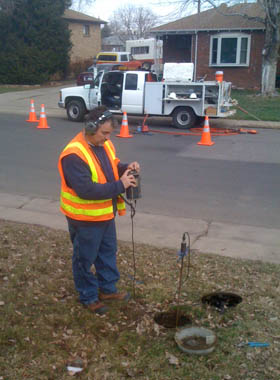
Looking for leaks before they reach the surface
One of the hardest things about finding a leak is listening for it.
Was that hollow swooshing the sound of a sprinkler running? A washing machine filling? Or the sound of a leak that’s causing lost revenue, water waste and potential damage to surrounding infrastructure?
Each year, a four-member crew surveys roughly 500 miles of pipe, searching for sneaky leaks that have yet to gurgle up from the ground.
“A pipe could leak for years and you’d never know it,” said Jim Aragon, one of the crew members with the leak detection program. “It would just go right into the Platte River, following the storm sewer or another conduit. Leaks find the path of least resistance.”
One of the goals of Denver Water’s leak detection program is to survey the entire distribution system – which has almost 3,000 miles of pipe – and pinpoint the leaks to help our operations and maintenance crews repair the problem spots.
Finding those non-surfacing leaks cuts down on expensive main breaks, identifies weak pipes, reduces excavation costs and curtails water waste. Over the past five years, Denver Water leak detection employees surveyed more than 3,800 miles of pipe and pinpointed more than 500 underground leaks. They also worked with our operations repair crews to locate nearly 600 surfacing leaks.
Fixing all those leaks saved an estimated 138 million gallons of water — water that would have been unaccounted for.
“It’s really important,” Aragon said. “We’re saving hundreds of thousands of gallons every year.”
To find the leaks, crews place data loggers on top of a pipe on a street corner’s valve box.
The data loggers capture three days’ worth of information about the pipe, documenting any unusually steady sound frequencies that might signal a leaky pipe.
Once the data loggers show that a leak is in the area, crews place correlating equipment with magnetic transducers on pipes or valves to send frequencies to a computer. The computer then helps the crew narrow down the leak’s location on the pipe.
As soon as the readings say they’re close, they’ll drill through the asphalt, stick a metal rod into the hole so it touches the pipe, and use headphones to listen for the hollow swooshing sound of a leak, usually marking the spot within 3 feet of the actual leak.
“The big thing is being able to tune your ear to the sound of a leak,” said Rodney Edwards, a water quality investigator who worked in leak detection for four years. “You’ll hear cars passing, laundry machines running. You have to really key into what a leak sounds like.”
Finding leaks is like solving a big audible puzzle. The hollow leak sound may be a sprinkler system running or a hose gushing with water. Sometimes, when they’re searching for leaks in busy urban areas, the crew will have to return late at night so they can concentrate on the sound of the leak without the interruption of car horns and diesel engines.
“The equipment will help indicate that there’s a leak in the area,” said Joe Duran, distribution operations supervisor. “But they have to investigate, correlate and analyze data to actually detect the problem.”
A few years ago, maintenance workers at the zoo couldn’t figure out why the lemur pond and the duck pond kept filling up with water. Aragon and fellow crew member, Mike Sanchez, headed there after-hours to avoid the noisy crowds.
“We went out there at night and the animals were going crazy,” Aragon said. “We were listening for the leak and heard bears growling from the other side of the zoo.”
They found two problem valves that were allowing water to flow into the ponds, even after the zoo’s maintenance staff had attempted to shut them off.
Most of the time, the pipe’s age is to blame for the hidden leaks. Sometimes, other utility crews may have nicked a pipe while repairing something else underground, causing a gradual and destructive problem.
“Customers find it very interesting that we’re out there looking for leaks and trying to conserve,” Edwards said. “They say, ‘you’re doing what? How cool.’”


